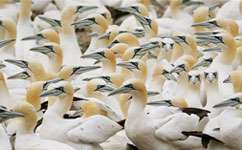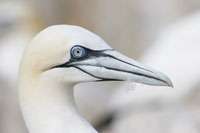Gannet foraging sharpens thinking about marine conservation

New research into seabirds highlights the need for marine conservation to consider the different behaviours of males and females in the species it aims to protect.
For the first time, female gannets have been shown to travel much further from the colony during the breeding season than males, and to rely on different prey.
This means the sexes could be affected differently by things like pollution and renewable energy installations, or changes in climate or fisheries policies.
A team led by Plymouth University studied a colony of northern gannet, Morus bassanus, at Grassholm, Wales, between 2006 and 2009. They used GPS trackers and chemical analysis of blood and feathers to work out where, and what, the birds were eating.
'At a time when the development of marine reserves is a key goal, our findings mean that effective protection of both sexes must occur at different scales,' says Dr. Stephen Votier of the University of Plymouth, one of the authors of the report which is published in Marine Ecology Progress Series.
Different foraging behavior between sexes is common in many animals but the reasons behind it are not clear cut. It's often thought that differences in body size make one sex more successful at competing for food, but gannet males and females are very similar in size.

To understand what could be behind the gannets' behavior, the researchers studied individuals of all ages – breeding adults and younger birds – throughout the whole annual cycle and across consecutive years.
GPS trackers revealed that, during the breeding season, females with young traveled much farther from the colony than the males when looking for food. But outside the breeding season, or among younger birds, there was no difference in foraging behavior.
This suggests that parental roles, rather than body size, could be important. Male gannets spend more time defending the nest, leaving females free to travel farther for food – although the trackers also revealed that their longer journeys did not keep the females away from home for much longer than the males.
Analysis of stable isotope ratios provided further detail on the gannets' diet. Isotopes are different types of the same chemical element, and their proportions vary in different marine creatures. When the gannets feed, the isotope ratios of their prey are reflected in the birds' blood cells and in new feather growth.
In particular, the isotopes revealed that male gannets eat a higher proportion of white fish than females. Because white fish species live much deeper than gannets can dive, it's likely that these are discards from fishing boats.
While it's not clear why males rely more on discards, it does suggest the sexes will be affected differently if fishery policies reduce discard levels, which would reducing a major food source for the males but potentially also reduce the risk for the hundreds of birds caught by fisheries every year.
More information: C Stauss, et al. Sex-specific foraging behaviour in northern gannets Morus bassanus: incidence and implications. Mar Ecol Prog Ser 457: 151-162, 2012. doi: 10.2254/meps09734
Journal information: Marine Ecology Progress Series
Provided by PlanetEarth Online
This story is republished courtesy of Planet Earth online, a free, companion website to the award-winning magazine Planet Earth published and funded by the Natural Environment Research Council (NERC).



















